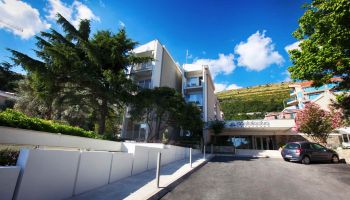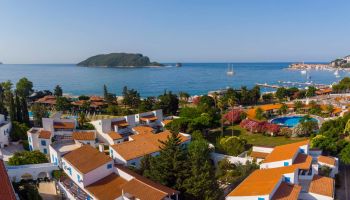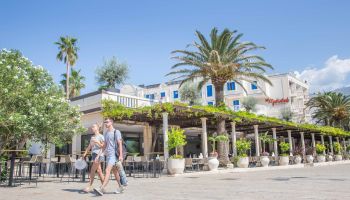Budva, a blend of antique past and contemporary urban life

Budva is a city that welcomes many tourists every year. On one hand, it provides a peaceful refuge on fairytale beaches. On the other hand, it is the hotspot of buzzing nightlife.
Budva proves itself as the metropolis of tourism, year after year. The reason is clear – Budva has a lot to offer. Discos, clubs, and cafes – something for everyone's taste. In addition, Budva offers landscaped beaches, cultural and "family-friendly" activities.
Budva has around 18,000 citizens. The area of the city and its surroundings is called the Budva Riviera. The heart of Budva is The Old Town. There are many important historical buildings here.
You can reach Budva easily by car. If you do not own one, we recommend a professional car rental service. Choose the best car for you and discover the whole Budva Riviera.
Geographical coordinates: 42°10'-42°20' N and 18°48'-19°00' E.
Budva - a brief history
Ancient Budva came to be some 2,500 years ago. Since then, it has been one of the urban centers of the Adriatic. This is due to Budva’s great position and, even today, the city benefits from that.
In literature, Budva was first mentioned in the 5th century BC. Sophocles describes it as "the city of Illyria". The Illyrians left behind a rich legacy of great cultural and artistic value. You can see some of the items from that period at the City Museum in Budva.
The Illyrian tribes were present in this area until the arrival of the Greeks and Romans in the 4th century BC. And since Budva was under the rule of the Roman Empire until its fall in 395, many of the structures and remains found date back to that period. Excavations from this site paint a broader picture of migrations. Budva is, therefore, important not only for Montenegro but also for the entire region.

And when do the Slavs appear?
According to the data of the Byzantine emperor Constantine Porphyrogenitus, the Slavs first came to this area in the 9th century BC. In the following centuries, the Slavs gradually accepted Christianity.
In its long history, Budva was the target of many attacks. Starting with Avar and the Arabs, it fell under the territory of Duklja and Raska. After that, it passed into the hands of the Venetians, Austro-Hungarians, and the Balsics. It was only after World War II that the city was finally liberated.
What to see in Budva - You can't miss this
Old Town of Budva
This part of town has been known for decades as a place of cultural events. Within the town, you can also find charming souvenir shops, coffee shops, houses, and churches. Passing through the Old Town Gate, you will enter a time machine that takes you back to various historical eras. Its rich history is sometimes forgotten in the busy present.
Few people know that Budva is more than 2,500 years old. It was first inhabited by the Eheleans, an Illyrian tribe, who were ancestors of the Balkan nations.
After Illyrians, Greek, Roman, Venetian, and Slavs civilizations took turns. They all left pieces of history behind.
The Old Town was originally built as a fortress on an island near the coast. It was later joined to the mainland by a tombolo – essentially a natural sandy bridge. It was founded as a Greek "shopping center" because the Greeks, due to the presence of Illyrians, failed to conquer this area.
The architecture of the Old Town was mostly built during the Venetian Reign, in the XV century. At the very entrance, you can find the remains of the Roman Necropolis. Furthermore, the Church of St. John from the 7th century, Santa Maria in Punta, from the 9th century, and the Church of the Holy Trinity from 1804 are located in the heart of the city. In the city itself, there is also a Citadel, a city fortress, at the top of which is a summer stage. Traditionally, the City Theatre event is held on the stage. All of the above is a "must-see" in Budva.
After the earthquake that struck Montenegro in 1979, countless archaeological sites were discovered. Today, these remains can be seen in the Museum of the City of Budva, as well as throughout the Old Town.

Sveti Stefan (Saint Stephen)
Sveti Stefan is one of the most luxurious resorts on the Montenegrin coast. In contrast, in the past, it was a refuge for the settlers in the event of an attack. It was also a commercial, traffic center as well as the headquarters of the Pashtru Tribal Court or Bankada.
St. Stephen is named after the archdeacon Stephen. The church dedicated to him is located on the island itself. It is assumed that the Pastrovic tribe built their forts and houses here, during the 15th century.
Today, St. Stephen is visited by the richest elite and celebrities. This island is a symbol of luxury and generosity.

St. Nichola’s Island
At less than a kilometer from Budva, there is the island of St. Nichola’s. This island attracts curious tourists who want to explore its numerous coves, lush flora, and fauna. As the island itself is a hunting reserve, it is home to numerous animal species. Here you can spot deer, rabbits, mouflons, and birds. It feels like a tropical paradise, so locals nicknamed it Hawaii. When you reach it, you can sunbathe on the many secluded beaches with a total length of 840 meters, and a surface of 2,700 meters. Moreover, you can have your own piece of heaven, for a moment at least.
Milocerski Park
This park is, simply put, an oasis. It dates back to the beginning of the 20th century. You’ll notice many exotic plant species here, such as eucalyptus, tropical mimosa, medlars, agave, and others. Today, this park is a unique place for relaxation and walking. Milocerski Park is located right next to the King’s and Queen's beaches, which captivate with their wild beauty and exude regal energy.
Along the Queen's Beach is the residence of King Nicholas’. Here you can feel a touch of inconspicuous elegance and luxury as well as the abundance of untouched nature.
Museum of the City of Budva
Stories, legends, and history can sometimes be best experienced in museums. The Museum of the City of Budva is located in the Old Town, in a building dating back to the beginning of the 19th century. It contains a large number of items discovered in the second half of the 20th century. After the earthquake that hit Budva in 1979, various archeological remains from different points in Budva’s history were discovered under the rubbles.
The Museum of the City of Budva has permanent exhibits of the archaeological and ethnographic collections. On the ground floor is a lapidary that contains valuable precious stone artifacts. The archaeological collection consists of Hellenistic gold, various vases, jewelry, ornaments, tools, and more. The items on display vary in age. The oldest ones date back to the 5th century, while some of the younger ones are from the 16th century. All of them unite the cultures of the Illyrians, Greeks, Romans, Byzantines, and Slavs in this area.
The ethnographic exhibition contains objects ranging from the 18th to the 20th century.
Modern Gallery of Budva
A place that will satisfy the curiosity of art lovers is the Modern Gallery of Budva. This exhibition space was first opened in 1972. The first exhibition brought together contemporary Yugoslav and world expressionists in one place. The modern gallery boasts a large number of organized exhibitions to meet the most famous artists from the territory of the former Yugoslavia.
Today it has 218 drawings, graphics, watercolors, and sculptural works. Among the sounding names of the art scene in the museum are works by Petar Lubarda, Milo Milunović, Risto Stijović, and many others.
Memorial home Stefan Mitrov Ljubisa
Stefan Mitrov Ljubisa (1824-1878) was a famous writer and politician from Budva. The ground floor of his hometown in the Old Town was transformed into a memorial home. There is an exhibition with written documents, books, and notes from his life.
He was secretary of the Budva municipality, MP, and president of the Dalmatian Parliament. In Budva, he is particularly known as a fighter for human rights and freedoms. Stefan Mitrov Ljubisa achieved remarkable results in politics.
In addition, he was involved in writing down folk tales and legends from the area. In this way, he helped preserve the cultural identity of Montenegro.
Churches
Churches are an important feature of every civilization. These buildings testify to the attitude of the people towards culture, religion, and art.
The Church of the Holy Trinity in Budva
The construction of the Church of the Holy Trinity in Budva began in 1798 and was completed in 1807. Its facade is made of alternating rows of red and white hewn stone. Above the west door is a rosette. In the interior of this building are icons of exceptional value, with a special emphasis on iconostasis made by Greek iconologists in the 19th century.
In front of the church is a grave of the famous writer and politician from Budva - Stefan Mitrov Ljubisa.
The Church of St. John (Sv. Ivan) in Budva
The Catholic Church of St. John (Sv. Ivan), built in the 7th century, is one of the oldest churches on the Montenegrin coast. The most spectacular part of it is a 36-meter high bell tower built in 1867.
In this church, there is an icon depicting the Virgin Mary, the patron saint of the entire city. The icon was transferred from the church of Santa Maria in Punta in 1807. Also, its altar wall was made of the famous Murano glass by the painter Ivo Dulcic. Today's appearance of the church dates back to the second half of the 17th century when it was reconstructed after the earthquake of 1667.
Along with the Santa Maria in Punta Church, the Church of St. Sava the Sanctified (Sv. Sava Osveceni), and the Church of the Holy Trinity adorns the Old Town. There are also the remains of an early Christian basilica from the 5th century in close vicinity as well as the Church of St. Mary in the Citadel.
The Church of St. Sava the Sanctified (Crkva Sv. Save Osvećenog)
This very small church is located near the church of Santa Maria in Punta in the Old Town. It belongs to the order of pre-Romanesque churches of a single-nave (aisles) basis. During the Venetian rule, both Catholic and Orthodox rituals were held in this church.
Podostrog Monastery
As the name suggests, the Podostrog Monastery is located under the hill Ostrog on the very edge of Budva. This monastery complex consists of two churches from the 15th and 16th centuries. It is dedicated to the Assumption of the Most Holy Mother of God. A frequent visitor to the monastery complex was the famous Montenegrin bishop and poet Petar II Petrović Njegos. It was at this very spot that Njegos wrote a part of "The Mountain Wreath" as well as the epic "Svobodijada".
Gradiste Monastery
The Gradiste Monastery is located in Buljarica. In 1597, the first spelling book was written in this monastery. It was written by the monks Stefan of Pastrovic and Sava and then printed in Venice. The Gradiste Monastery is one of the protected cultural and historical monuments of Montenegro.
Praskvica Monastery
About ten kilometers from Budva, in the village of Przno, there is a monastery called Praskvica. The 11th-century monastery of Praskvica was named after a nearby spring. Namely, the water of this spring smells like a peach variety (praskva), hence the name.
Many valuable artifacts such as the golden cross of Tsar Dusan, frescoes of inestimable value, sabers from war campaigns as well as the chalice of the Russian Tsar Paul, are held in the monastery.
Stanjevici Monastery
The Stanjevici Monastery is an extremely important cultural site. Its present appearance and function date back to the 18th century. It is located in the village of Pobori and consists of a monastery fortress, a church of St. Trinity, a gun shop, and the main building. The Stanjevici Monastery was one of the main spiritual and folk centers in Montenegro.
Metropolitan Petar I Petrović Njegos resided in the monastery during his reign (from 1790-1809). From here, St. Peter of Cetinje wrote the epistles as well as the famous "Light of the Microcosm". Other historically important figures, such as Vuk Karadzic, also stayed there. Shortly after Vuk's visit, the monastery was handed over to the Habsburg Monarchy. From the money received, which was paid to St. Peter of Cetinje by Austria-Hungary, the Billiard Palace in Cetinje was built.
Legends about Budva
The legend of the creation of Budva is related to the story of Cadmus and Harmony. Cadmus was a Phoenician prince, the son of King Agenor of Tire and Queen Telephassa. When the supreme ancient Greek god Zeus kidnaps Europe, Cadmus' sister, he sets off on the path to save her.
Along the way, the gods gave Cadmus Harmony for a wife. They lived in prosperity until Cadmus killed the holy dragon in Thebes. He was soon expelled, and after a long escape, he found refuge on the Adriatic coast. This is where Cadmus founded the city of Bouthoe, today's Budva.
Cadmus came to Budva on oxen, so it is believed that this beauty of the Adriatic was named after them. In Greek, bous means ox.
When the end drew near, Cadmus and Harmony were turned into snakes and crawled into a colorful grove. After that, they were never seen again. Today we can find such groves all over Budva.
The legend about the Tunja of Budva
Tunja of Budva, a long sea reef, divides the Bay of Budva into two parts. It is located between the Slovenska beach and the island of St. Nicholas.
This wonder of nature with its rich biodiversity served as inspiration for a legend. According to folk tradition, St. Sava went on a pilgrimage to the Holy Land. Because of a great storm, St. Sava’s ship remained anchored at Budva’s St. Nichola’s Island. While waiting, St. Sava threw a handful of rocks into the sea and created today's reef. Thanks to this, St. Sava and his party headed to the island of St. Nicholas, and continued their journey to the Holy Land.
Why is Mogren called Mogren?
And why many residents of Budva do not enter the sea before June 13th?
Many will agree that Mogren is one of the most famous beaches of the Budva Riviera. But, not many know that this beach bears a legend of a sailor.
Once upon a time, the seas were the main battlefields. In one fight between the Spanish galley and the pirates, the galley was sunk with most of its crew. The only survivor was Mogrini who found salvation on this land. On June 13th, he built the church of St. Anthony, in gratitude for his life. To this day, on that date, a mass in honor of this saint is held in front of the remains of the church. And many locals believe that the sea should not be entered before that date.

The tragic fate of the Skocidevojka (Maiden’s leap)
The place Skocidevojka, located near Budva, arouses the curiosity of visitors because of its name. This site tells the story of a girl in love who met a tragic fate. Once upon a time, Rose lived near Budva. She loved a guy named Stevan very much. However, she couldn't deal with the fact that she was promised to another man, so she took her own life by jumping off a cliff. For her, that was the only road to freedom. Today, the name Skocidevojka preserves the memory of this tragic event. Besides, it reminds us of the power of true love.
A place where you can see the painting of a saint with a donkey's head
Have you ever thought that words "a saint with a donkey's head" would be used in the same sentence? Believe it or not, this icon, representing the figure of St. Christopher, does exist. It is located in the Church of St. Nichola’s, in the monastery complex of Gradiste. It is believed that the altar partition was made by Vasilije Rafailovic in 1795.
Such a depiction is rarely found in Christian iconography. It represents a kind of legend about Saint Christopher. Namely, God gave him incredible beauty that aroused the affection of many girls. That's why Christopher asked him to give him an uglier look to avoid temptations. That is how the saint got a donkey's head.
The Legend about the Budva Ballerina
The poetic sculpture of the ballerina is located near the Old Town of Budva. The ballerina is the work of Gradimir Aleksic. Although she has been standing in the same place for a long time, her destiny is filled with legends.
One of the legends says that the statue represents a young girl who loved a young sailor. A young man sailed away one day but never came back. The girl, waiting for him for a long time, died one morning at the place where the sculpture is today.
This statue ended up in the sea on one occasion, due to a storm. Luckily, it was found very soon and put back in its place. Perhaps, that young girl wanted to pursue her eternal love, yet again.
According to others, the inscription that can be found near the sculpture tells the real truth "In the cove behind the rock, while swimming with friends, July 13th, 1935, at the age of 22, a student of electrical engineering Stevan Tomasevic became the victim of a sea monster, and lost his life ”.
Some Budvan residents also believe that the ballerina is dedicated to a nameless gymnast who drowned somewhere in the sea expanse. After all, there are also convictions that the ballerina is dedicated to the daughter of a wealthy local.
As with legends, their credibility cannot be determined. Today, however, Aleksic's ballerina is a symbol of love, dedication, sacrifice, and unity with nature.
Fortress Kosmac
On the main road between Cetinje and Budva, there is this interesting building with a view of the Budva Riviera.
The fortress dates back to the mid-19th century and served as a border crossing between Montenegro and Austria-Hungary. The three-layer walls are made of different types of stone, from very smooth to irregular. Inside is a central bastion with rounded smaller bastions. There used to be water tanks on the inside, as well as barracks.
Mogren Fortress
The Mogren Fortress is located on top of the cape with the same name, between the beaches Mogren and Jaz. This 19th-century building is just two kilometers from Budva. Today, it has been almost completely destroyed by time and the area has been reclaimed by nature.
Despite its current condition, the fortress offers a beautiful view of Budva. You can reach the remains easily, just off the main road to Kotor. On the second kilometer of the road, there is a macadam road that leads to the fortress. In its vicinity, under the cape of the same name, Budva's Mogren beach captivates with its beauty.
Beaches
Numerous sandy, rocky and mixed beaches of Budva are classified as of the highest quality. They stretch for 38 kilometers along the coast, which makes them a significant asset of this city.
Jaz
One of the most interesting beaches in Budva, Jaz Beach, is located about 2.5 km from Budva, towards Kotor. The total length of the beach is 1,200 meters.
Jaz is a very common choice of tourists for vacation and recreation during the summer. Because of its large area, there is always enough room for all its visitors. Here you can spend your vacation days relaxing in one of many restaurants and cafes. Alternatively, you can rent a lounge chair or even just bring your beach towel and relax on the hot sand, the choice is yours. Behind the beach, there is a large car camp as well as football fields. There is also a 400m long dedicated nudist area of the beach if that's your groove.
Over the years, this beach served as a venue for many grand events such as the Sea Dance Festival. Also, some of the music industry's greatest names held concerts here: Madonna, The Rolling Stones, Lenny Kravitz, etc.

Mogren
Just a few-minute walk from the Old Town in Budva, there is an interesting little bay - Mogren. There are actually two beaches here, connected with a tunnel through the rocks. Mogren is one of the most beautiful beaches on the Montenegrin coast. A scenic narrow path, at times hidden under the cliffs, leads to this beach. So, even if you are visiting during the winter, you should check it out. The beach was named after Mogrini, a Spanish sailor who found salvation on the beach, after a shipwreck. As a show of his gratitude, he built a church dedicated to St. Anthony here. Remains of this church can still be found on Mogren to this day.

Richard's head
The Old Town in Budva is one of the most visited places on the Montenegrin coast. Therefore, the popularity of Richard's head, which is located right next to the walls of the Old Town, is not surprising. The beach is named after the actor Richard Widmark, who shot a movie called "Long Boats" at this very place in 1963. The beach is around 100 meters long.

Slovenska beach, formerly known as Podpolje
The Slovenska beach is one of the longest beaches of the Budva Riviera. It is a famous tourist spot that offers a variety of attractions. Some of them include bungee jumping, water skiing, and paragliding. The beach is pebbled and/or sandy at times. Across from it is the beautiful Island of Saint Nichola’s. The beach is connected to this island by an underwater sand bar. This bar is a part of the legend of St. Nichola’s and his pilgrimage to the Holy Land.
The current name Slovenska beach was named after the Czechs who vacationed in Budva in the first half of the 20th century.
There is also a large hotel complex of the same name here. This is arguably one of the most beautiful areas in the town – It is car-free, there is plenty of greenery and a couple of large parks, as well as a long promenade. On top of that, the coastal architecture is pleasing to the eye AND the soul.

Becici, the most beautiful beach in Europe
Becici beach is one of the largest beaches in the southern part of the Adriatic. The beach is 1,950 meters long, and there is something for everyone’s taste here. The beach in Becici won the title of the most beautiful beach in Europe at the Grand Prix in Paris in 1935.
Kamenovo
At the beginning of the Budva Riviera, which has as many as 16 beaches, there is a beach named Kamenovo. About 330 meters long, this sandy oasis provides an ideal retreat during hot summer days. The beach is located just off the main road to Bar and is easily accessible. You can also reach it by foot through a pedestrian tunnel that connects it to Becici and Rafiliovici. And when you get to it, there's a great restaurant and a beach bar. All of this provides a dreamy experience of the Montenegrin summer, filled with lots of fun.

Przno – protected nature reserve
Przno is a small (260m), partly sandy, and partly rocky beach. It is, however, a recognized protected nature reserve. Once upon a time, Przno used to be a fishing village. The feeling of a small coastal village still remains. But, there are many seafood restaurants and wine bars here today. Perfect for those looking to have a high-quality meal in a romantic setting.
Milocer
Compared to other beaches on the Budva Riviera, Milocer stands out with its exotic flora. It is located near the former summer house of the Karadordevic dynasty, dating back to 1934. The Milocer park, just next to the beach, is rich in rare and exotic species of plants. Together with the hotel, the Milocer beach represents an exclusive summer resort, with a particularly attractive ambiance.

Crvena glavica – named after the rocks of reddish color
Crvena glavica, located in the nudist camp of the same name, is part of a complex that includes sandy and rocky beaches. The total length of the complex is 500 meters. Crvena glavica is named after sand and rocks that reflect a reddish shade (crvena means red). This beach is a place where you can feel peace and experience a pure connection to nature.
Petrovac
The main beach in Petrovac is 600 m long. Nearby is a variety of restaurants, cafes, and hotels. From the beach, you can also see two islands. Katič and Sveta Nedjelja adorn Petrovac with their uniqueness.

Lucice
At only 500 meters from Petrovac, there is a beach named Lucice. You can reach it by taking a short walk along the pine forest, or even by car. The nature is truly breathtaking and unique here. While there is a couple of restaurants here, they are tucked in behind the pine trees. So, the scenery remains undisturbed. It is 220 meters long and it is a jewel of the Budva Riviera.
Buljarica
Buljarica Bay extends from cape Resovo brdo to Dubovice. It is the largest beach on the Budva Riviera. It is just 2km away from Petrovac, along the road to Bar. It is about 2,250 m long and is mostly covered in gravel. There are several car camps and resorts near the beach. Buljarica is a very important natural reserve of the wetland ecosystem. For this reason, it is a frequent stop for nature lovers.
Cultural events in Budva
The most famous cultural events in Budva are Budva City Theatre, the music festival "Song of the Mediterranean" and "Music Festival Budva". Furthermore, "Budvanska noc", "Petrovacka noc", "Veliki kerneval", "International Dance Festival" and New Year's Eve concerts are events that gather audiences from all over the world. The "Budva Municipality Day", which is held on November 22, is also marked with many cultural and sports events.
During the year you can visit museums and galleries in Budva. Apart from the permanent exhibits, the Museum of the City of Budva also hosts literary evenings, cultural events, and exhibitions by renowned artists. Budva is also the seat of "Zeta Film", the only production house in Montenegro.
Famous artists, such as Spiro Bocaric, Filip Kovacevic, Antun Kojivic, Stjepan Zanovic, Slobodan Slovinic and Jovan Ivanovic were born in this town.
Sports in Budva
Budva, being a metropolis of tourism that it is, can accommodate anyone's interests and needs. There are sports fields and halls, as well as activities for adrenaline lovers. There are many football and tennis courts in the city. It is also a home to well-known sports clubs such as FC “Mogren”, HC “Budvanska Rivijera”, BC “Budva” and BC “Mogren-HTP Milocer”. Budva has an open-air seawater pool near the Old Town and an indoor swimming pool within the complex Slovenska beach.
You can also enjoy diving, flyboarding, water skiing, pedal boat trips, or glass-floor submarine tours.
Budva restaurants and cafe
In Budva, you can find many restaurants. Among the restaurants that offer an extraordinary culinary experience, we highlight:
Restaurant Mogren
Dukley Beach Lounge
Dvorište by Picasso
Restaurant Maslina
Restaurant Slovenska Plaza
Mogren City Tavern
Nightlife in Budva
One of the things that makes Budva a metropolis of tourism, that it is, is an incredibly rich nightlife. There are world-class clubs, which bring some of the world’s greatest musicians to Budva, year after year. If a night of unforgettable fun and partying is what you are looking for, we suggest you do not miss:
Top Hill Discotheque – the best club in the world
In 2012, Top Hill won the title of the best nightclub in the world at a competition in Monte Carlo. This is certainly reason enough to visit it.
Omnia
Another in a series of discos you should visit this summer. The Omnia discotheque offers a modern ambiance, a good sound system, and well-known names of the musical industry.
Casper Old Town Budva
During the season, the Casper Jazz Club is a favorite place for lovers of quality jazz sound. But even if you don’t like jazz, this place has an incredible vibe.
Hide Day and Night club
If you want to experience something never before seen before in this part of the world, visit the Hide Club. This newly opened club is hidden in plain sight, right on the Slovenska plaza. Enjoy modern rhythms and dancing with a view of the entire coastline of Budva.
Accommodation
Hotel Aleksandar
Hotel Slovenska Plaza
Hotel Mogren
Hotel Palas
Hotel Castellastva


-72ceb9aa.jpeg)





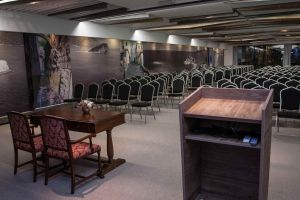


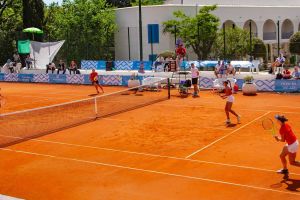

-c8b6c678.jpeg)


